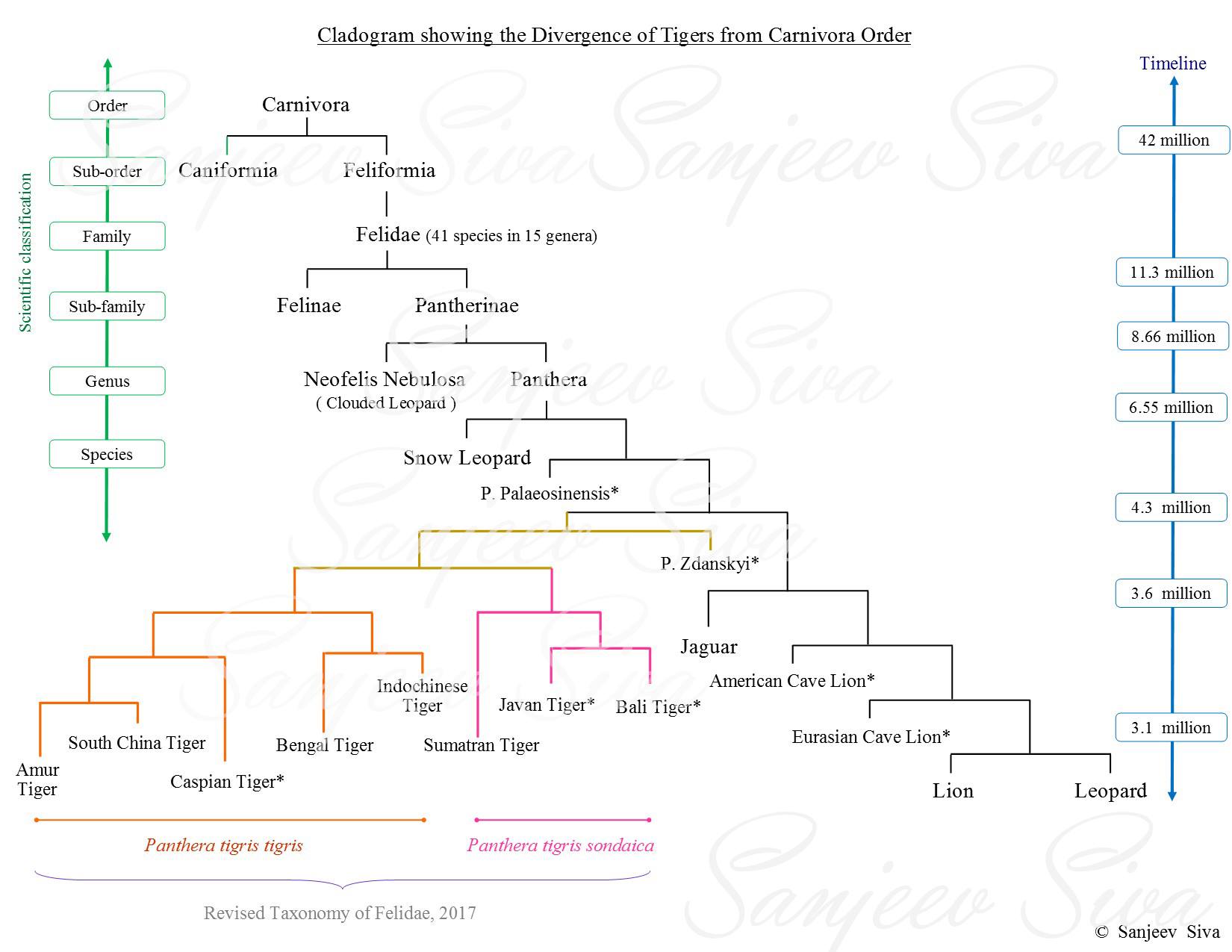The Evolution of a Tiger
Tigers are one of the most charismatic species of the mega fauna. Every year, lakhs of tourists throng the protected tiger reserves, the last lairs holding a very fragile population, to catch a glimpse of the magnificent cat. Studies and observations done aplenty, tigers are collared and tagged, DNA and genome sequenced, yet, not much is known about the tigers, their genealogy, origin and evolution or this knowledge is limited to scholarly papers and studies.
A good idea of origins, timeline, genealogy and phylogenetic relations adds a biological meaning to the already existing data collected through observation, sampling and other studies (not limited to collaring, molecular analysis).
This article is meant to give a basic to intermediate exposure; to discuss in detail at length is beyond the purview. However, a few links to academic, experimental, and doctoral articles are provided at the bottom. The same would give a deeper insight.
Chapter 1: Origins and Classification
The below cladogram approximates the timelines of the split, starting from the Order to the Genus, and the species. After the Cretaceous–Paleogene extinction event approximately 65 million years ago, Mammalia Class began to form.
Miacids were supposed to be the precursors to all the Carnivores. Miacids belonged to the primitive carnivoramorphans that existed between 33 and 62 million years ago. Order Carnivora formed, which then started to split into Caniformia and Feliformia more than 40 million years ago; Sub-orders, families and sub-families, genera followed over the next few millions of years. From the sub-order Feliformia, Felidae Family formed and subsequently split into Felinae and Pantherinae sub-families.
The earliest known Panthera genus was formed which was known as Panthera Palaeosinensis, initially thought to be the ancestor to the modern day tigers. It was later established that P. Palaeosinensis shares more of a sister relationship with Jaguars and Lions.
As late as 2004, a skull of the early Pleistocene era found in Longdan, Dongxiang County, Gansu Province of north-western China is now widely believed to an ancestor of modern tiger, predating all other known fossils by atleast half a million years. This species named Panthera Zdanskyi (also called Longdan Tiger) is morphologically similar to tigers. A Jaguar-sized species, the Longdan Tiger is now viewed as the sister branch of the Panthera Tigris species.
There is a definite ‘adaptive radiation’ between P. Zdanskyi and P. Tigris, with the latter evolving into a bigger sized and larger numbered sub-species due to factors such as new environment niches; climatic conditions; availability, size and type of prey.
Tigers occupy (or occupied) a wide range of temperate zones from far north of Russia to close to equator, and within the species P. Tigris, the tigers are of varying sizes, with the tigers present towards colder areas tending to have bigger bodies, following ‘Bergmann's rule’.
Traditionally, the species P. Tigris was further divided into 11 sub-species, 2 of them – Trinil and Japanese tigers became extinct in the prehistoric times and atleast 3 of them being declared extinct (a 4th, the South China Tiger is declared functionally extinct with no individual sighted in the wild over the the past few decades). The genetic diversity is considered very low between these species, and that they are mostly common in relation to pelage patterns, body measurements, gut lengths, cranio-dental structures, and molecular biology.
As per the revised taxonomy of the Felidae in 2017, the Sumatran, Bali and Javan tigers are classified as Panthera tigris sondaica (Sunda tiger sub-species), and the rest of the 6 tigers – Bengal, Indochinese, Siberian, South China, Malayan and the extinct Caspian tigers are now listed under the nominate Panthera tigris tigris. This classification purportedly is intended for conservation, breeding in zoos and future re-wilding or trans-location programs. The same has been criticized by opponents who say that all the sub-species are genetically different.
Within the Panthera tigris tigris subspecies, Amur or Siberian tigers are the biggest while Bengal or Indian tigers are the heaviest of the extant species. Owing to the length of the sub-continent, the differences in the climate, habitat, availability, type and preference of prey, there are variations in sizes and appearances including color of the coat, mane length etc.
The size of an individual tiger additionally may vary based on the optimization of Daily Energy Expenditure (DEE) and Basal Metabolic Rates (BMR). This is the very reason why, in wild, no Siberian tiger is ever recorded to be heavier (or even bigger) than a Bengal tiger.

